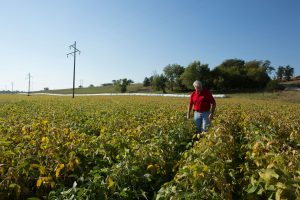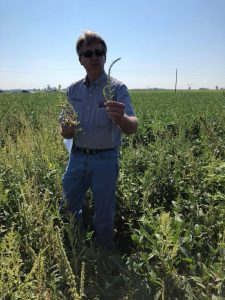Take Action: Pesticide Resistance Management
By Dusty Sonnenberg, CCA, Ohio Field Leader: a project of the Ohio Soybean Council and soybean checkoff.
Production threats facing soybean farmers are constantly changing. Weeds, Insects, and Diseases create stress on crops that can contribute to reduced yields throughout the growing season. Take Action: Pesticide Resistance Management is an initiative of the United Soybean Board to help growers better identify and understand these production challenges and find solutions to protect their crops while reducing the threat of resistance developing in the pest.
Take Action is both a website and an app for smart phones and tablets. Take Action: Pesticide Resistance Management gives farmers the tools needed to follow an integrated pest management strategy with the resources to correctly identify pests, determine thresholds, and select treatment options the reduce the chances of developing pesticide resistance.
The Take Action website is divided into a resources section and a management section. Both sections are broken down into three key areas; Herbicide-Resistance Management, Disease-Resistance Management, and Insect-Resistance Management. Farmers can request a Take Action Kit that contains a: Herbicide Classification Chart, Fungicide Classification Chart, and Insecticide Classification Chart, as well as several fact sheets. It also provides resources to help farmers manage their fields. Long term resistance management requires more than pest control aimed only at minimizing crop loss in any one season. These resistance management resources can be used to develop a diverse plan of action.
There are four areas of focus in the Take Action program: Cultural Practices, Scouting and Identification, Economic Thresholds, and Pesticide Efficacy. Implementing these cultural practices should be conducted prior to a chemical control application. They are all tied closely together in an integrated pest management system.
While crop rotation may not typically be considered by some as an IPM strategy, it is a cultural practice that can go a long way to breaking the cycle of pests in a field. Rotating to non-host crops reduces the opportunity for pests to reproduce in a continuous crop scenario.
Scouting and the identification of a specific pest is important when considering threshold infestations and product selection. Selecting the correct pesticide to be used for control, as well as timing of pesticide application based on the life stage of the pest, and the crop is important to achieve acceptable control while reducing the risk of developing resistance.
The difference between agronomic and economic pest thresholds is critical when determining if an application of a pesticide will yield a return on investment (ROI). While there may be agronomic damage and yield reduction that occurs due to pest being present, the timing of the application (based on crop growth stage and pest lifecycle stage) and the market value of the crop will determine if the cost of control is justified.
Pesticide product efficacy is enhanced by selecting pesticides that have the greatest chance of obtaining the desired level of control from an application. To protect product efficacy, rotating between products with different modes of action throughout the season is advised. This reduces the opportunity for resistance to develop.
The Take Action website also has a Dicamba update, and associated resources to help farmers navigate the changing regulatory landscape surrounding this group of products.
National and state-specific weed, disease and insect management information from university extension scientists and researchers is available and can be sorted by state and resistance type. Numerous pdfs are available in the resource section covering topics such as: How to use the herbicide classification chart, Economic returns of herbicide resistance management, Best management practices for herbicide resistance, Identification and control of herbicide resistant weeds. There is information on management of pests such as: Morning Glory, Velvetleaf, Waterhemp, Palmer Amaranth, herbicide-resistant horseweed, sudden death syndrome, and soybean aphids. There are other links to resources from various land grant universities, and also resources for preventing corn insect resistance.
The Take Action App provides all the Take Action Kit items in a digital format.
To learn more or to download the app visit: www.Iwilltakeaction.com